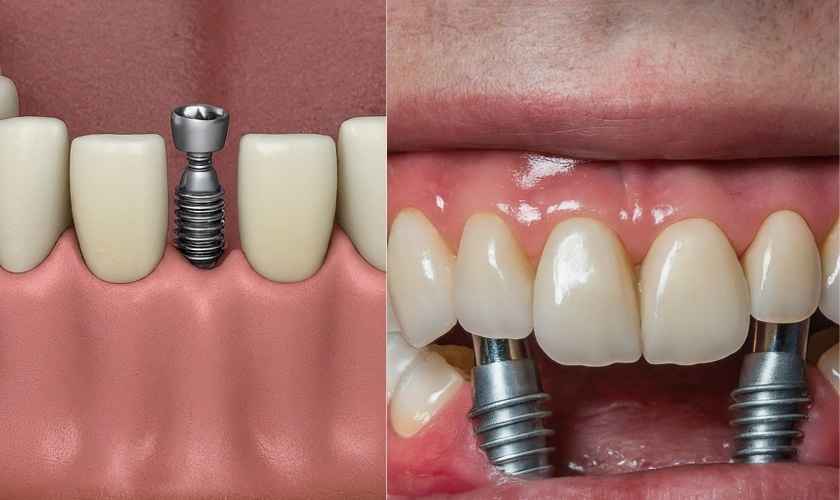Some Known Facts About Dental Sense.
Some Known Facts About Dental Sense.
Blog Article
The Definitive Guide for Dental Sense
Table of ContentsSome Known Incorrect Statements About Dental Sense Things about Dental SenseHow Dental Sense can Save You Time, Stress, and Money.What Does Dental Sense Do?
are medical tools operatively dental implanted into the jaw to bring back an individual's capability to eat or their appearance. They supply support for fabricated (phony) teeth, such as crowns, bridges, or dentures. When a tooth is lost as a result of injury or condition, a person can experience difficulties such as rapid bone loss, defective speech, or changes to eating patterns that result in pain.Dental dental implant systems contain an oral implant body and dental implant joint and might also consist of an abutment fixation screw. Dental implant vs bridge. The dental implant body is operatively put in the jawbone in area of the tooth's origin. The dental implant abutment is normally affixed to the implant body by the joint addiction screw and extends with gum tissues into the mouth to sustain the attached fabricated teeth
(https://www.mixcloud.com/dentalsense1/)Framework of The Oral Implant System choosing dental implants, talk with your dental company regarding the potential benefits and threats, and whether you are a candidate for the treatment. Points to consider: Your overall health and wellness is a vital consider establishing whether you are a good candidate for oral implants, the length of time it will take to heal, and the length of time the dental implant may remain in place.
Smoking may impact the recovery procedure and reduce the long-term success of the dental implant. The recovery process for the implant body may take several months or longer, throughout which time you normally have a momentary abutment instead of the tooth. the oral implant procedure: Carefully follow the oral hygiene guidelines provided to you by your oral provider.
Little Known Facts About Dental Sense.
Implant failing can lead to the demand for an additional surgery to take care of or change the implant system. Recovers the capability to chew Restores cosmetic look Helps keep the jawbone from reducing because of bone loss Protects the wellness of the bordering bone and periodontals Assists maintain adjacent (close-by) teeth steady Boosts lifestyle Damages to bordering all-natural teeth throughout implant positioning Injury to the surrounding tissues during surgical procedure, such as sinus perforation Injury throughout surgical treatment (for instance, fracture of surrounding jawbone) Inadequate function, such as seeming like the teeth do not attack together typically A sensation that the tooth hangs or turning in area arising from an abutment screw loosening up Implant body failing (looseness of the dental implant body) because of systemic infection, which might be more probable in individuals with unrestrained diabetics issues because of neighborhood infection in bone and periodontals supporting the dental implant body because of postponed recovery, which may be more probable in people that smoke Trouble cleaning up the periodontals around the dental implant, resulting in inadequate oral hygiene Untreated periodontal disease Post-surgical numbness due to nerve impingement or damage Always notify health care suppliers and imaging specialists that you have oral implants before any magnetic vibration imaging (MRI) or x-ray procedures.
FDA is not knowledgeable about any kind of negative events reported for MRI or x-ray procedures with dental implants. Oral implants systems are commonly constructed from materials that adhere to global consensus requirements of the International Company for Standardization (ISO) or ASTM International. These criteria have details of what makes a risk-free Continued material.

An oral implant is a framework that changes a missing tooth. With screw-like tools, the specialist inserts a dental implant right into the jawbone, and it serves as an anchor for a fabricated tooth, called a crown. A gadget called a joint connects the synthetic tooth to the oral implant. The crown is personalized to fit the individual's mouth and match the shade of their teeth.
The Best Guide To Dental Sense
Some individuals are not qualified for oral implant surgical procedure. It is for oral surgeons to operate people with: intense illnessuncontrollable metabolic diseasebone or soft cells disease or infectionIf these concerns are fixed, a person can have the surgical procedure. In, dental doctors abstain from operating people with: If individuals with any one of the above undertake oral implant surgery, there is a higher threat of the dental implant stopping working.

Dental implant surgical procedure is a customized process. It's not the exact same for every person. However the adhering to offers a basic introduction of what you can anticipate your dentist, dental cosmetic surgeon, periodontist or prosthodontist to do: Place the implant operatively. Give you time to heal. Connect the message and final crown, bridge or denture.
Next off, your specialist will very carefully put the dental implant right into your jaw. Your doctor will rearrange your gums and shut the cut with stitches. If your dental implant is near the front of your mouth, your dental practitioner will certainly make a temporary tooth for you to use up until you heal. This way, you will not have a gap in your smile while you recover.
6 Easy Facts About Dental Sense Described
Your provider can tell you what to anticipate in your scenario. During the recovery phase, your jawbone ought to fuse to the dental implant. This process, called osseointegration, is critical for stability and lasting success. This procedure can take anywhere from three to nine months. Sometimes, it might take much longer.
Once your dental implant heals, your dental practitioner can attach the abutment (small connector article) and your final restoration (crown, bridge or denture). This generally takes concerning one hour to complete and might require a 2nd small surgical treatment. You should not really feel any type of discomfort throughout your dental implant treatment since your service provider will utilize medication to numb your periodontals.
Report this page